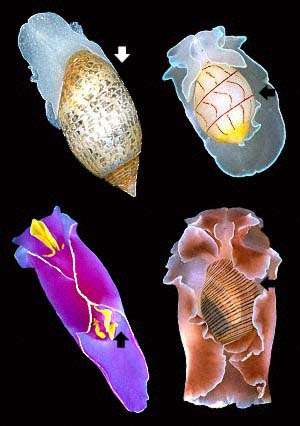
Detorsion - how snails became sea slugs
PHOTO
Cephalaspid Bubble Shells.
Upper Left: Pupa sulcata (Acteonidae)
Upper Right: Bullina lineata (Bullinidae)
Lower Right: Hydatina physis (Hydatinidae)
Lower Left: Sagaminopteron ornatum (Gastropteridae)
PHOTOS: Bill Rudman.
RELATED TOPIC
The evolution of sea slugs from marine snails has occurred a number of times in the Opisthobranchia. The cephalaspid Bubble Shells show many examples of how the shell was gradually lost and the animal became larger, more elaborate and brightly coloured. Associated with this is the process of "detorsion" where the mantle cavity and its associated organs move from above the head down the right side of the body towards the posterior end. The arrow indicates the functional position of the mantle cavity in each species. In the animals illustrated we have Pupa sulcata with a heavy shell, operculum, and relatively small uncoloured animal, and Bullina lineata in which the animal is larger, the operculum is retained and the shell is becoming thinner. In Hydatina physis, there is a thin shell, large brightly coloured animal, no operculum, and the mantle opening has moved down the right side of the body. In the brightly coloured Sagaminopteron, the shell is completely lost and the "mantle cavity" is reduced to a small posterior flap that does not cover the gills, which can just be seen above the arrow.
See What is a slug?.
Authorship detailsRudman, W.B., 1998 (October 29) Detorsion - how snails became sea slugs. [In] Sea Slug Forum. Australian Museum, Sydney. Available from http://www.seaslugforum.net/factsheet/detort
